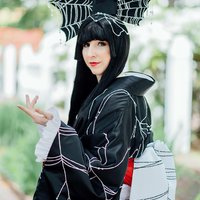I've wanted to make a kimono for a number of years, but I've never gotten around to it until this costume. I didn't use authentic fabrics (due to cost) but otherwise I did a lot of research to make sure that everything else was as authentic as possible. Making CLAMP costumes is addictive and apparently so is hand embroidery and hand beading (at least for me).
A whole lot of research, fabric, and time went into this costume. It took about 5 months total from beginning to end due to my choice to hand embroider and hand bead the entire outer kimono, obi, and head piece. Below is a breakdown for each piece of the costume from the inside out:
Hadajuban - (undergarment worn under kimono) made from white cotton and finished with french seams and doubled over hems. I also made 8 koshihimo (80" long ties used to secure the various kimono pieces in place) with the same cotton.
Padding - I originally made some padding with cotton and batting to eliminate my curves, but I ended up not needing it.
Nagajuban- (under kimono) this was made from a white faux dupioni silk and lined with a thin white cotton. I used the measurements for a maiko geisha kimono meaning that the overall length is 6' and the sleeves are 39.5" long. In the reference art you can see she is wearing a white kimono under the outer kimono, but I decided to add in some hand painted smoke details in a houmongi pattern (sleeves and gradient hem) because Yuuko is often pictured around smoke or in kimonos with smoke patterns.
Datejime - (half sized obi used to secure the nagajuban) made from black casa satin and hand painted with a gradient butterfly pattern. Unfortunately this piece can't be seen at all when I'm wearing the full costume because it's covered by the outer kimono and obi.
Kimono - made from black casa satin and lined with red casa crepe. The kimono, like the nagajuban, is a furisode kimono with the same measurements as those worn by maiko geisha. The hem of the kimono is also padded using batting. The spiderweb pattern on the kimono is a hand embroidered split stitch. There are also opalescent plastic beads of various sizes hand sewn to the webbing to give the appearance of dew.
Obi accessories - I made my obi padding from some extra red casa crepe and batting, my obi ita (stiffening board to keep the obi smooth) from a cardboard folder secured with elastic), obi makura (pillow for the obi knot to rest on) from a block of upholstery foam covered in white cotton, obiage (scarf for the top of the obi) from red casa chiffon), and obijime (decorative tie around the obi) from red home decor cording.
Obi - my obi is a full darari obi (20' long by 12.5" wide) and it is also hand embroidered with a split stitch and hand beaded with various opalescent plastic beads. The spider is a combination of stem stitch, satin stitch, short and long stitch, split stitch, and french knots. The obi is made from white casa satin, interfacing, and ivory casa satin.
Hair accessories - the spiderweb piece on the wig is made from black casa satin that was hand embroidered with a split stitch and hand beaded. I used heat and bond and wire to help secure and support the front and back pieces together. The webbing on the top of the wig is extra embroidery floss and beads that were attached to a band of black casa satin that was secured around the "hair rectangle"/top knot.
Kiseru - my "opium pipe" that was actually traditionally used to smoke tobacco is made out of a wooden dowel and sculpy.
Wig - I used a Le Tigre Long in black from Arda Wigs as my base wig. I sewed in a bang clip and trimmed the bangs and side pieces to the approximately correct length (later corrected when I wore the wig). The "hair rectangle"/top knot was made from wefts glued and hair sprayed to 2 pieces of felt with several lengths of 16 gauge wire sandwiched in between.
Awards: Best Overall Craftsmanship - Anime Boston 2015
